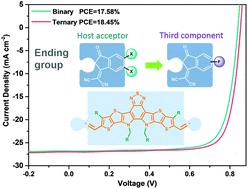当前位置:
X-MOL 学术
›
Energy Environ. Sci.
›
论文详情
Our official English website, www.x-mol.net, welcomes your
feedback! (Note: you will need to create a separate account there.)
A facile strategy for third-component selection in non-fullerene acceptor-based ternary organic solar cells
Energy & Environmental Science ( IF 32.4 ) Pub Date : 2021-07-14 , DOI: 10.1039/d1ee01864g Yun Li 1, 2, 3, 4 , Yunhao Cai 1, 2, 3, 4 , Yuanpeng Xie 1, 2, 3, 4 , Junhua Song 1, 2, 3, 4 , Hongbo Wu 4, 5, 6, 7, 8 , Zheng Tang 4, 5, 6, 7, 8 , Jie Zhang 4, 9, 10, 11 , Fei Huang 4, 9, 10, 11 , Yanming Sun 1, 2, 3, 4
Energy & Environmental Science ( IF 32.4 ) Pub Date : 2021-07-14 , DOI: 10.1039/d1ee01864g Yun Li 1, 2, 3, 4 , Yunhao Cai 1, 2, 3, 4 , Yuanpeng Xie 1, 2, 3, 4 , Junhua Song 1, 2, 3, 4 , Hongbo Wu 4, 5, 6, 7, 8 , Zheng Tang 4, 5, 6, 7, 8 , Jie Zhang 4, 9, 10, 11 , Fei Huang 4, 9, 10, 11 , Yanming Sun 1, 2, 3, 4
Affiliation

|
The ternary strategy has been proved to be an efficient approach to improve the power conversion efficiency (PCE) of organic solar cells (OSCs). However, little attention has been paid to deriving the general design principle for selecting an appropriate third component. Herein, we proposed a facile strategy for third-component selection in non-fullerene acceptor-based ternary OSCs. By sharing the same central unit with the host acceptor and a single fluorinated end group, the designed non-fullerene acceptor can successfully function as the third component in ternary OSCs. Following this design principle, we synthesized the BTP-F acceptor, and then incorporated it into the PM6:BTP-eC9 blend. Encouragingly, the optimized ternary OSC exhibited a high PCE of 18.45%, which is among the highest efficiency values reported for OSCs so far. In addition, the PM6:BTP-eC9:BTP-F ternary OSC displayed superior stability compared to the host system. Systematic characterizations reveal that the introduction of BTP-F into the ternary blend increases the charge transport, improves the active-layer morphology and reduces non-radiative recombination, therefore leading to a simultaneously enhanced short-circuit current, fill factor and open-circuit voltage. Furthermore, the Y6-F and L8-BO-F acceptors have been also synthesized as the third components in ternary OSCs. Compared with the binary devices, the ternary devices all exhibited improved PCEs. These results confirm the general application of the strategy we proposed, which provides a new way to further improve the efficiency of ternary OSCs.
中文翻译:

基于非富勒烯受体的三元有机太阳能电池中第三组分选择的简便策略
三元策略已被证明是提高有机太阳能电池 (OSC) 功率转换效率 (PCE) 的有效方法。然而,很少有人关注推导选择合适的第三组件的一般设计原则。在此,我们提出了一种在基于非富勒烯受体的三元 OSC 中选择第三组分的简便策略。通过与主体受体和单个氟化端基共享相同的中心单元,设计的非富勒烯受体可以成功地作为三元 OSC 中的第三组分。遵循这一设计原则,我们合成了 BTP-F 受体,然后将其掺入 PM6:BTP-eC9 混合物中。令人鼓舞的是,优化的三元 OSC 表现出 18.45% 的高 PCE,这是迄今为止报告的 OSC 的最高效率值之一。此外,与主机系统相比,PM6:BTP-eC9:BTP-F 三元 OSC 显示出卓越的稳定性。系统表征表明,将 BTP-F 引入三元混合物中增加了电荷传输,改善了活性层形态并减少了非辐射复合,从而同时提高了短路电流、填充因子和开路电压. 此外,Y6-F 和 L8-BO-F 受体也被合成为三元 OSC 中的第三组分。与二元器件相比,三元器件均表现出改善的 PCE。这些结果证实了我们提出的策略的普遍应用,这为进一步提高三元 OSC 的效率提供了一种新方法。系统表征表明,将 BTP-F 引入三元混合物中增加了电荷传输,改善了有源层形态并减少了非辐射复合,从而同时提高了短路电流、填充因子和开路电压. 此外,Y6-F 和 L8-BO-F 受体也被合成为三元 OSC 中的第三组分。与二元器件相比,三元器件均表现出改善的 PCE。这些结果证实了我们提出的策略的普遍应用,这为进一步提高三元 OSC 的效率提供了一种新方法。系统表征表明,将 BTP-F 引入三元混合物中增加了电荷传输,改善了有源层形态并减少了非辐射复合,从而同时提高了短路电流、填充因子和开路电压. 此外,Y6-F 和 L8-BO-F 受体也被合成为三元 OSC 中的第三组分。与二元器件相比,三元器件均表现出改善的 PCE。这些结果证实了我们提出的策略的普遍应用,这为进一步提高三元 OSC 的效率提供了一种新方法。因此导致同时提高的短路电流、填充因子和开路电压。此外,Y6-F 和 L8-BO-F 受体也被合成为三元 OSC 中的第三组分。与二元器件相比,三元器件均表现出改善的 PCE。这些结果证实了我们提出的策略的普遍应用,这为进一步提高三元 OSC 的效率提供了一种新方法。因此导致同时提高的短路电流、填充因子和开路电压。此外,Y6-F 和 L8-BO-F 受体也被合成为三元 OSC 中的第三组分。与二元器件相比,三元器件均表现出改善的 PCE。这些结果证实了我们提出的策略的普遍应用,这为进一步提高三元 OSC 的效率提供了一种新方法。
更新日期:2021-08-09
中文翻译:

基于非富勒烯受体的三元有机太阳能电池中第三组分选择的简便策略
三元策略已被证明是提高有机太阳能电池 (OSC) 功率转换效率 (PCE) 的有效方法。然而,很少有人关注推导选择合适的第三组件的一般设计原则。在此,我们提出了一种在基于非富勒烯受体的三元 OSC 中选择第三组分的简便策略。通过与主体受体和单个氟化端基共享相同的中心单元,设计的非富勒烯受体可以成功地作为三元 OSC 中的第三组分。遵循这一设计原则,我们合成了 BTP-F 受体,然后将其掺入 PM6:BTP-eC9 混合物中。令人鼓舞的是,优化的三元 OSC 表现出 18.45% 的高 PCE,这是迄今为止报告的 OSC 的最高效率值之一。此外,与主机系统相比,PM6:BTP-eC9:BTP-F 三元 OSC 显示出卓越的稳定性。系统表征表明,将 BTP-F 引入三元混合物中增加了电荷传输,改善了活性层形态并减少了非辐射复合,从而同时提高了短路电流、填充因子和开路电压. 此外,Y6-F 和 L8-BO-F 受体也被合成为三元 OSC 中的第三组分。与二元器件相比,三元器件均表现出改善的 PCE。这些结果证实了我们提出的策略的普遍应用,这为进一步提高三元 OSC 的效率提供了一种新方法。系统表征表明,将 BTP-F 引入三元混合物中增加了电荷传输,改善了有源层形态并减少了非辐射复合,从而同时提高了短路电流、填充因子和开路电压. 此外,Y6-F 和 L8-BO-F 受体也被合成为三元 OSC 中的第三组分。与二元器件相比,三元器件均表现出改善的 PCE。这些结果证实了我们提出的策略的普遍应用,这为进一步提高三元 OSC 的效率提供了一种新方法。系统表征表明,将 BTP-F 引入三元混合物中增加了电荷传输,改善了有源层形态并减少了非辐射复合,从而同时提高了短路电流、填充因子和开路电压. 此外,Y6-F 和 L8-BO-F 受体也被合成为三元 OSC 中的第三组分。与二元器件相比,三元器件均表现出改善的 PCE。这些结果证实了我们提出的策略的普遍应用,这为进一步提高三元 OSC 的效率提供了一种新方法。因此导致同时提高的短路电流、填充因子和开路电压。此外,Y6-F 和 L8-BO-F 受体也被合成为三元 OSC 中的第三组分。与二元器件相比,三元器件均表现出改善的 PCE。这些结果证实了我们提出的策略的普遍应用,这为进一步提高三元 OSC 的效率提供了一种新方法。因此导致同时提高的短路电流、填充因子和开路电压。此外,Y6-F 和 L8-BO-F 受体也被合成为三元 OSC 中的第三组分。与二元器件相比,三元器件均表现出改善的 PCE。这些结果证实了我们提出的策略的普遍应用,这为进一步提高三元 OSC 的效率提供了一种新方法。











































 京公网安备 11010802027423号
京公网安备 11010802027423号